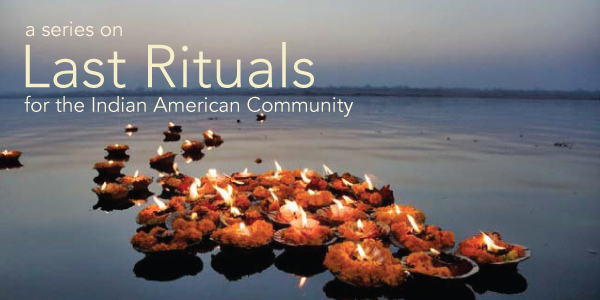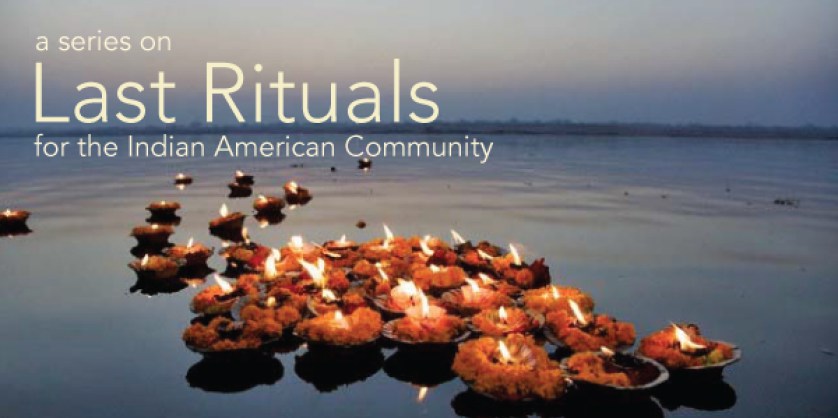(Editor’s note: This is the part-5 of Last Rituals Series published by INDIA New England News in collaboration with the Desai Foundation. There are many different religions and communities in India and each has different beliefs, customs, prayers, and practices regarding last rituals. In today’s series, we focus on last Sikh rites.)
Sikhs believe in reincarnation and cremate their dead. In the days before the cremation, the body is washed with yogurt and water while reciting the Gurmantar Waheguru or Mool Mantar. The deceased is then clothed with clean articles of clothing and if the Sikh was baptized, the outfit is completed with the five K’s. The Sukmani Sahib or Psalm of peace is recited, as well as the word, “Waheguru,” meaning the wonderful lord.
 Right before the cremation the body is transported by the funeral home director to a temple or another hall for prayers and blessings. Hymns are recited by all attending the service “to induce feeling[s] of consolation and courage.” To conclude the prayers, an Ardas is recited for further blessings before the body is cremated. At the crematory, the eldest son will be the one to push the button for the cremation. Before the button is pressed, prayers are again recited. These prayers include more hymns, the Kirtan Sohlia, and the final prayer or “Antim Ardas.”
Right before the cremation the body is transported by the funeral home director to a temple or another hall for prayers and blessings. Hymns are recited by all attending the service “to induce feeling[s] of consolation and courage.” To conclude the prayers, an Ardas is recited for further blessings before the body is cremated. At the crematory, the eldest son will be the one to push the button for the cremation. Before the button is pressed, prayers are again recited. These prayers include more hymns, the Kirtan Sohlia, and the final prayer or “Antim Ardas.”
The purpose of the prayers in the ceremonies is to bless the Soul on its journey to liberation and to be united with God. To dispose of the ashes, Sikhs place them in a body of running water, such as a river, so the Soul may be united with God. In the ten days following, prayers are recited at the Gurdwara as a structured mourning time. The ceremony performed during these ten days is called the Sahaj Path Bhog ceremony, which entails a reading of the Sahaj Paath.
On the tenth day, when the reading of the Shaj Paath is complete, family and friends get together at the Gurdwara to sing hymns, recite Saloks of the ninth Guru Tegh Bahadur, Ramkali Saad or the Call of God, and Hukam. “Karah Parshad is distributed to the congregation,” and Langar is served. A new head of the family is sometimes declared as well. This declaration occurs when the oldest male member of the family is given a turban. These rituals vary depending on family tradition and what the family feels would be appropriate. Adopted from SikhiWiki, below is a detailed description of the process for the body before, during, and after cremation.
The Official Rehit Maryada:
The following is from the sgpc website: http://www.sgpc.net
- The body of a dying or dead person, if it is on a cot, must not be taken off the cot and put on the floor. Nor must a lit lamp be placed beside, or a cow got bestowed in donation by, him/her or for his/her good or any other ceremony, contrary to Guru’s way, performed. Only Gurbani should be recited or “Waheguru, Waheguru” repeated by his/her side.
- When someone shuffles the mortal coil, the survivors must not grieve or raise a hue and cry or indulge in breast beating. To induce a mood of resignation to God’s will, it is desirable to recite Gurbani Shabads or repeat “Waheguru”.
- However young the deceased, the body should be cremated. However, where arrangements for cremation cannot be made, there should be no qualm about the body being immersed in flowing water or disposed of in any other manner.
- As to the time of cremation, no consideration as to whether it should take place during day or night should carry any weight.
- The dead body should be bathed and clothed in clean clothes. While that is done, the Sikh symbols 5Ks – Kangha, Kachha, Karha, Kirpan – should not be taken off. Thereafter putting the body on a plank or coffin, Ardas about its being taken away for disposal be offered. The hearse or coffin should then be lifted and taken to the cremation ground. While the body is being carried to the cremation ground, Shabads or hymns that induce feelings of detachment should be recited. On reaching the cremation ground, the pyre should be laid. Then the Ardas for consigning the body to fire be offered. The dead body should then he placed on the pyre and the son or any other relation or friend of the deceased should set fire to it.
- The accompanying congregation should sit at a reasonable distance and listen to kirtan or carry on collective singing of Shabads or recitation of detachment-inducing Shabads. When the pyre is fully aflame, the Kirtan Sohila (prescribed preretirement night Scriptural prayer) be recited and the Ardas offered. (Piercing the Skull half an hour or so after the pyre has been burning with a rod or something else in the belief that will secure the release of the Soul – kapal kriya – is contrary to the Guru’s tenets). The congregation should then leave.
- Coming back home, a reading of the Guru Granth Sahib should be commenced at home or in a nearby Gurdwara, and after reciting the six stanzas of the Anand Sahib, the Ardas, offered and Karah Prashad (sacred pudding) distributed. The reading of the Guru Granth Sahib should be completed on the tenth day. If the reading cannot, or is sought not to, be completed on the tenth day, some other day may be appointed for the conclusion of the reading having regard to the convenience of the relatives. The reading of the Guru Granth Sahib should he carried out by the members of the household of the deceased and relatives in cooperation. if possible, Kirtan may be held every night. No funeral ceremony remains to be performed after the “tenth day.”
- When the pyre is burnt out, the whole bulk of the ashes, including the burnt bones should be gathered up and immersed in flowing water or buried at that very place and the ground leveled. Raising a monument to the memory of the deceased at the place where his dead body is cremated is taboo.
- Adh Marg (the ceremony of breaking the pot used for bathing the dead body amid doleful cries half way towards the cremation ground), organised lamentation by women, foorhi (sitting on a straw mat in mouming for a certain period), diva (keeping an oil lamp lit for 360 days after the death in the belief that that will light the path of the deceased), Pind (ritual donating of lumps of rice flour, oat flour, or solidified milk (khoa) for ten days after death), kirya (concluding the funeral proceedings ritualistically, serving meals and making offerings by way of Shradh, Budha Marna (waving of whisk, over the hearse of an old person’s dead body and decorating the hearse with festoons), etc. are contrary to the approved code. So too is the picking of the burnt bones from the ashes of the pyre for immersing in the Ganga, at Patalpuri (Kiratpur), at Kartarpur Sahib or at any other such place.5
The last rituals as performed by Sikhs help affirm their belief in the afterlife and facilitate the Soul’s journey to God. While these rituals help with the coping process and provide comfort to the bereaved, remember that a variation of these last rites or just doing certain rituals is perfectly fine. You should do what you feel comfortable doing and what is appropriate for the person you are honoring.








